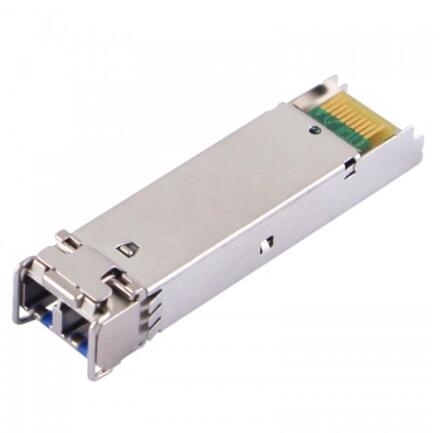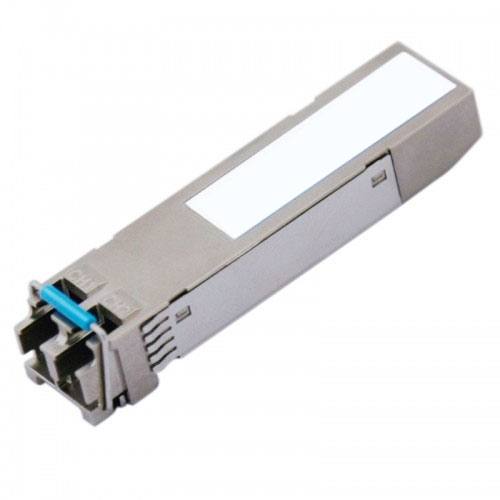- Related articles
- Optical Transceivers for Cisco N5548UPM-6N2248TP Switch
- Optical Transceivers for Cisco WS-C2960S-48LPS-L Switch
- Optical Transceivers for Cisco SG500-28P-K9-G5 Switch
- Optical Transceivers for Cisco SLM2048PT-UK Switch
- Fiber Optic Solutions for Cisco C3KX-NM-10G Module
- What Is GYTA33 Optical Fiber Cable?
- What is 1000BASE Transceiver?
- All Cisco MFEFX1's information (List price, Specs, Datasheet PDF, Compatibility matrix)
- Optical Transceivers for Cisco WS-C3560CX-12PD-S Switch
- Optical Transceivers for Cisco SF500-24P-K9-G5 Switch

Definition:
A gigabit interface converter (GBIC) is a standard for transceivers, commonly used with Gigabit Ethernet and fibre channel in the 2000s. By offering a standard, hot swappable electrical interface, one gigabit port can support a wide range of physical media, from copper to long-wave single-mode optical fiber, at lengths of hundreds of kilometers.
Compact small form-factor pluggable CSFP transceiver and a compact small form-factor CSFF transceiver supports network systems, especially those deploying single-fiber bidirectional transceivers in high density applications. The CSFP MSA defines a transceiver mechanical form-factor with latching mechanism and a host board, SFP-like, electrical edge connector and cage. The CSFF MSA also defines a transceiver mechanical form-factor. The dual-channel CSFP has the same mechanical dimensions as the industry-standard SFP transceiver and is compatible with the standard SFP cage. The single-channel CSFP and CSFF are half the size of the industry-standard SFP and SFF packages.
Difference between GBIC and CSFP:
GBIC
- Gigabit Ethernet 1000base-SX/LX/XD/ZX at 1.25Gbs/s Optional
- Wavelength: 850nm/1310nm/1550nm
- Single +3.3V or +5V power supply
- Ho-pluggable Duplex SC
- Eye safety, meet laser class 1, compliant with IEC60825-1
- Compliant with Tecordia (Bellcore) GR-468-CORE
- Compliant with specification for IEEE-802.3
- Compliant with ANSI spec. for Fiber channel applications at 1.06Gb/s
CSFP
- Support up to 1.25Gbps Data Links
- Single 3.3V Power supply and TTL Logic Interface
- 2XBi-directional transceivers in 1 Compact SFP transceiver package
- Class 1 FDA and IEC60825-1 Laser Safety Compliant
- Operating Case Temperature Standard: 0~+70C and Industrial -40~+85C
- Compliant with CSFP MSA Option 2 or Option 1
- Compliant with Digital Diagnostic Monitor Interface SFF-8472
Comparison of GBIC and CSFP
| Package | Data Rate/Application | Wavelength | Distance | Interface |
| GBIC |
1000M Ethernet 1.25G Ethernet/SDH/SONET/Fiber Channel |
850nm 1310nm 1550nm CWDM 1470nm~1610nm BIDI WDM 1310/1490nm BIDI WDM 1310/1550nm BIDI WDM 1490/1310nm BIDI WDM 1550/1310nm |
100m 300m 550m 10km 20km 40km 70km 80km 100km |
SC RJ45 |
| CSFP | 1.25G Ethernet/SDH/SONET/Fiber Channel |
BIDI WDM 1310/1490nm BIDI WDM 1490/1310nm |
10km 20km |
LC |
Difference between GBIC and SFP:
In order to interconnect a fiber optic medium into a motherboard, you need to have a connector like the GBIC or SFP. “GBIC” stands for “Gigabit Interface Converter” and was quite popular in the 1990s. It served as a standard way of connecting to different media like copper and fiber optic cables. In contrast, “SFP” stands for “Small Form-Factor Pluggable,” which also serves the very same purpose as GBIC. The main difference between GBIC and SFP is their size. SFP is considerably smaller than GBIC.
The difference in size is very desirable for many people, especially for those who deal with lots of them, because it will take up a lot less space. Considering that space in a server location is quite limited, using SFP lets you put more within one rack unit than if you used GBIC. Because of this single difference, SFP rapidly gained popularity with administrators who want to maximize their space. As SFP became more popular, GBIC also fell out of favor. Nowadays, GBIC is considered to be obsolete, and you would be hard pressed to find vendors that still carry equipment that is compatible with GBIC. SFP is still widely being used nowadays but is also under pressure from newer standards like SFP+.
GBIC and SFP Module—When to Choose What?
Knowing the differences between these two modules, then which one should you choose? In general, it actually depends on the line card or the switch you have. Usually, the line cards and switches comes with empty GBIC or SFP slots where you need to purchase the GBIC or SFP modules respectively and insert in those empty slot. However, if you already have a switch or line card which has GBIC slots you have to use GBICs, simply because SFPs won’t fit in and vice versa.
Another case where you don’t have a switch or line card and want to make a decision whether to use a GBIC or SFP will actually depend on the number of interfaces required and availability of the switches and line cards specific model. For example, if you want two fiber interfaces on a line card on 6500 switch, you won’t go for a 48 port SFP line card, instead you’ll use a 2 port GBIC line card. If you need some 24 fiber interfaces you won’t use a 16 (or 18 not sure) port GBIC line card, you’ll use a 48 port SFP line card.
Conclusion:
GBIC is the "GigaBit Interface Connector", and it is a little device that knows how to translate SX, LX, LH, etc., and or other types of gigabit signals (such as over copper), into a common format. GBIC connectors plug into slots in switches/routers, and are thus ways of changing the interface capabilities of the switches/routers without having to get new boards or replacing the switches/routers. They are, in a sense, media convertors.
The CSFP design is modular to enable configurations of integrated 2ch modules. The CSFP transceiver consists of 2-channel Bi-directional transceiver unit with five sections: the LD driver, the limiting amplifier, the digital diagnostic monitor, the 1310nm DFB laser and the 1490nm PIN photo-detector. The optical output can be disabled by a TTL logic high-level input of Tx Disable, and the system also can disable the module via I2C.
What is GBIC?
GBIC stands for Gigabit Interface Converter. It is a hot-pluggable optical transceiver that converts serial electric signals to optical ones. Further, this transceiver fits into the GBIC port on the Ethernet switch or router.
Compared with the first-generation 1×9 transceiver, this one provides hot-pluggable features – that allow IT technicians to insert and remove it without powering off the switch.
Let’s say the history. In 1995, the SFF Committeepresented and defined the GBIC form factor. Then, they launched the MSA specifications called SFF-8053(or INF-8053) and updated the specification in later years. The latest version Rev 5.5, was released on September 27, 2000.
Standards
The GBIC standard is non-proprietary and is defined by the Small Form Factor Committeein document number 8053i.[1]The first publication of the proposal was in November 1995. A few corrections and additions were made through September 2000. Robert Snively of Brocade Communicationswas technical editor. Original contributors were AMP Incorporated, Compaq Computers, Sun Microsystems, and Vixel Corporation.
How many GBICs are there?
We can divide them into many types based on different benchmarks.
By Datarate
-
100BASE: support fast Ethernet and SDH/SONET OC3
-
622M: support SDH/SONET OC12
-
1G (1000BASE): support 1G fiber channel and gigabit Ethernet.
-
2G: support 2G fiber channel and 2.5G SDH/SONET
-
RJ45 GBIC: features RJ45 female connector, suitable for connecting with an ethernet cable
-
Multimode GBIC: ideal for the multimode fiber cable (OM1/OM2/OM3)
-
Singlemode GBIC: ideal for the singlemode fiber cable (OS1/OS2)
By Distance
-
T: stands for copper, commonly with 1000BASE-T speed, and transmits the signal over Cat 5 cable
-
SX: stands for short reach, typical link of 550m on OM2 fiber
-
LX: stands for long reach, typical link of 10km on OS2 fiber
-
EX: stands for extend reach, typical link of 40km on OS2 fiber
-
ZX: stands for extend long reach, a typical link of 70km on OS2 fiber
By application
-
CWDM: It means Coarse Wavelength Division Multiplexing, which helps to maximize the fiber Utilization efficiency
-
BiDi: Allow bi-directional transmission on one fiber, saving half of the cabling.
-
Duplex Fiber: transmit over one fiber and receive over another fiber, suitable for the regular duplex fiber cabling network
Introduce CSFP MSA and CSFF MSA:
The CSFP MSA defines a transceiver mechanical form-factor with latching mechanism and a host board, SFP-like, electrical edge connector and cage. The CSFF MSA also defines a transceiver mechanical form-factor. The Dual-Channel CSFP has the same mechanical dimensions as the industry standard SFP transceiver and is compatible with the standard SFP cage. The Single-Channel CSFP and CSFF are half the size of the industry standard SFP and SFF packages. The CSFF design is modular to enable configurations of integrated 1, 2 or 4 channel modules. These highly integrated compact transceiver modules will enable network system vendors to increase port density and data throughput, while reducing network equipment cost. GigalightCSFP transceivers are compatible with the Compact Small Form- Factor Pluggable (CSFP) Multi-Source Agreement (MSA).
What Is CSFP?
CSFP (Compact Small Form Factor Pluggable) is a Compact SFP, which develops a more advanced and compact CSFP package based on the current popular SFP package. By adopting dual channel, the design of the four channels, CSFP uses the existing SFP common interface, but reducing the overall dimensions of existing half of the industry standard and a quarter. By combining channel number, it can also be flexible configuration. If the traditional discrete element scheme is continued, it will be difficult to achieve the above functions in technology. CSFP combines with high integration of optoelectronic integrated technology, on the basis of all the technical advantages of a SFP, greatly decreasing the size of the shape of the optical transceiver modules and optical system, a significant increase in density of communication port and data throughput, reduce the system cost. It is expected to play a prominent role in the data communications market. CSFP has 155M, 1.25G and 2.5G in speed.























































